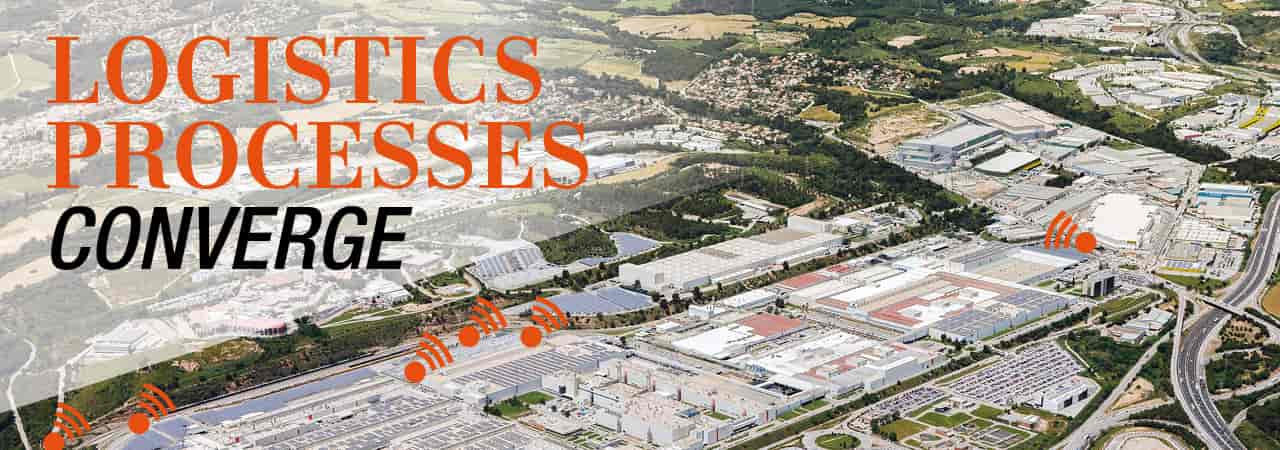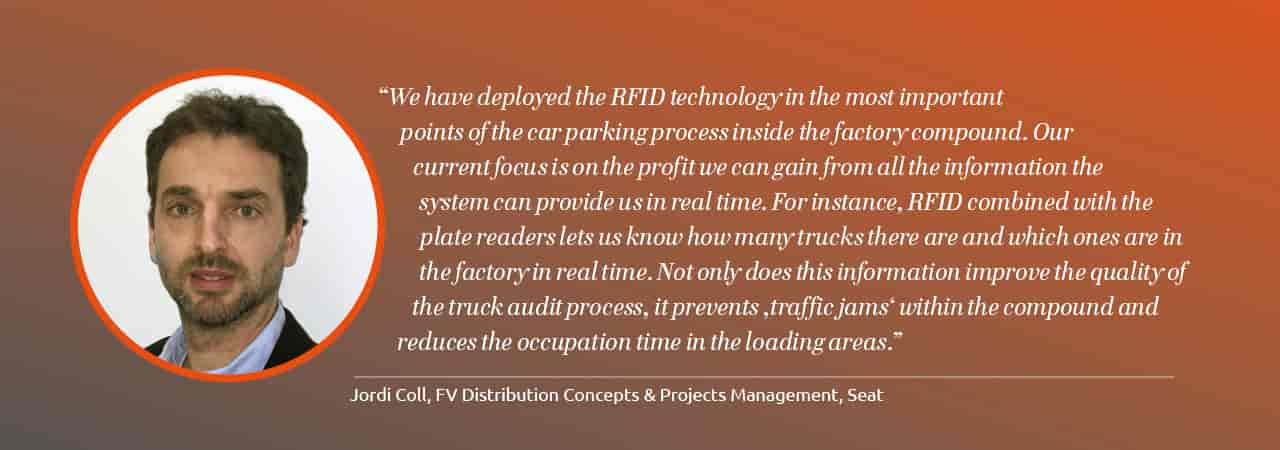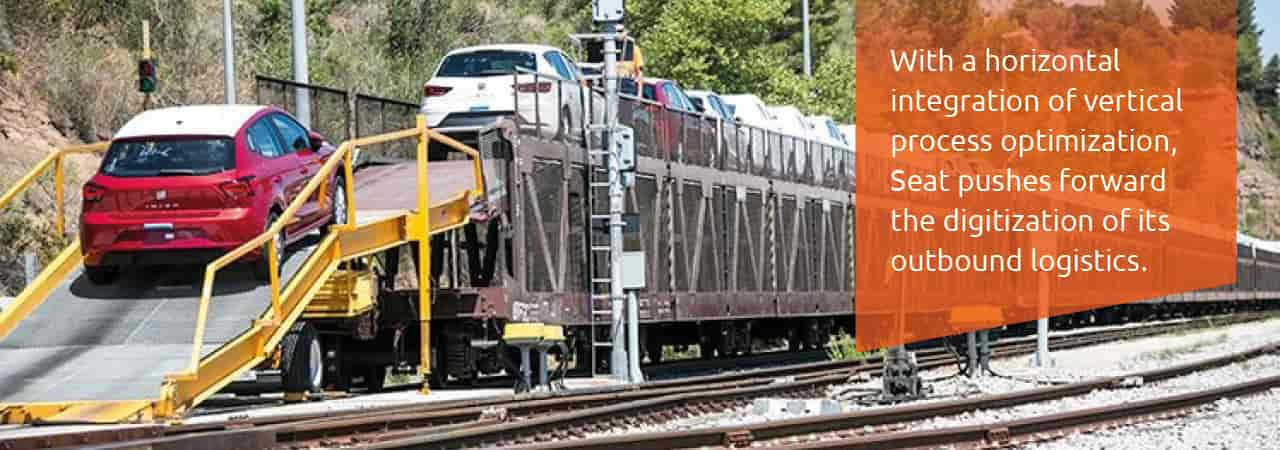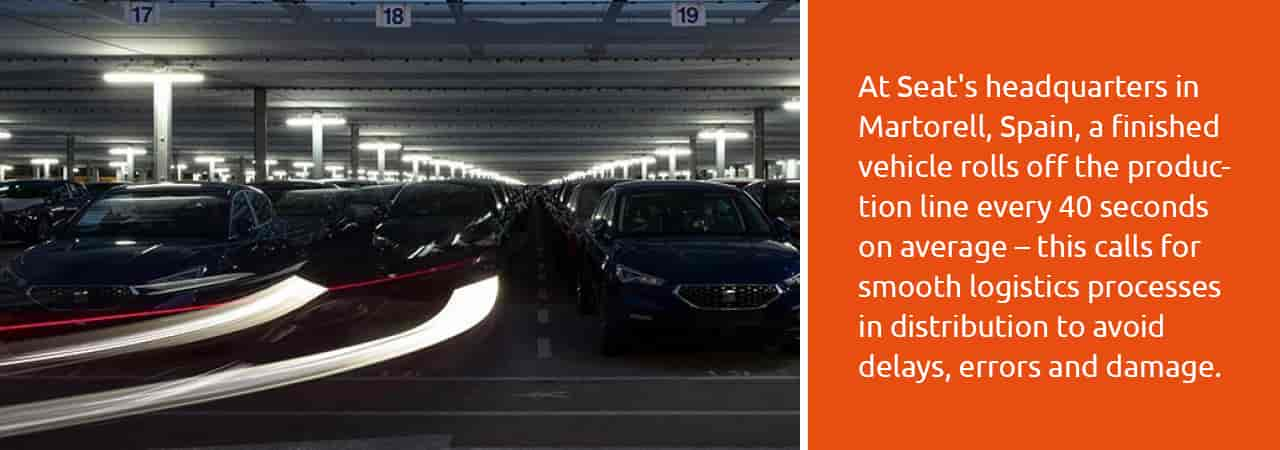Logistics Processes Converge!
Better decisions due to a clear information structure, time efficiency, increased productivity, and lower damage figures: digitization promises numerous advantages. An entirely new IT system at distribution, paperless information management, real time tracking – when implementing IoT, Seat focused on a holistic approach.
Manuel Medina, Vehicle Distribution Manager at Seat, talks about the horizontal integration of process optimization. In the past, the area's RFID, plate reader, and paperless distribution were developed vertically. Connecting established processes with the help of the new IT system creates synergy at the outbound logistics.
Jordi Coll, FV Distribution Concepts & Projects Management, Seat and Manuel Medina, Vehicle Distribution Manager, Seat, in an interview with RFID & Wireless IoT Global.
Steady Growth at Spanish Car Manufacturer Seat
Founded in 1950, car manufacturer Seat has been owned by the Volkswagen Group since 1986. Since its founding, the Seat headquarters has been located at the main factory site at Martorell, Spain. In 2019, Seat's vehicle and components exports achieved a turnover of 81 percent (9.014 billion euros). In 2019, Seat reached its highest production output since 2000 with a production total of 500,005 vehicles. This figure is a 5.4 percent increase compared to 2018 (474,300).
The company has three production sites in Martorell, Barcelona, and El Prat de Llobregat, Spain, at which, apart from those of Seat, a model for Audi and components for different Volkswagen Group brands are also manu-factured. On top of that, Seat vehicles are also produced other factories of the Group in Czech Republic, Germany, Portugal and Slovakia.
1. From Disruptive Process Optimization to a Competitive Advantage
In digitizing outbound logistics processes, Seat took a disruptive approach. In the eyes of Manuel Medina, this was the right way to meet current and future challenges. “Our customers, regardless if end-consumer or intermediate customers, demand increasingly transparent and consistent logistics. A single distinct expertise in digital technologies such as predictive analysis, automation with robots, advanced machine learning, or IoT undermines the goal of meeting the market requirements.”
In order to realize a sustainable advantage in the market environment, an effective integration of digital technologies at the outbound logistics is inevitable from Manuel Medina’s point of view. “This is why we at Seat do not only want to optimize individual, vertical processes with the help of digital technologies, but also intend to create horizontal synergy by connecting individual processes.”
2. Number Plate Identification with RFID
The extension of the RFID solution onsite was only one of four initial steps towards digitizing processes that were carried out by the outbound logistics team, as Manuel Medina reports: “The implementation of camera-based number plate reading devices began in 2017 at the factory entrances and, since 2018, was also done at the exits. In the first phase, the system allowed the automatic registration of trucks which were created in the IT system.
At this point, the system could not meet two requirements: The database was dependent on regular and reliable updates by the suppliers, and subcontractors could not be identified.” The solution: The combination with the RFID system already in use enables a more finegrained capture of car transport trucks. As soon as a truck is identified, the number plate is automatically added to the database. Therefore, there is no more dependence on information provided by logistics providers.
3. Paperless Distribution – Benefits at the Supplier and Factory
Another aspect that is part of the initial four steps of the outbound logistics digitization agenda is the introduction of a paperless distribution system at the Seat factory in Martorell. The project is currently in the conception phase. “So far, the document transfer is almost 100 percent on paper which causes inefficiency. In the light of our digitization ambitions, this circumstance is too slow, cumbersome, and prone to errors," says Manuel Medina.
The truck drivers only receive their documents after arriving on-site. Drivers and factory workers had to invest time without generating benefits. Furthermore, there is no benefit derived from running and maintaining the infrastructure required for the paper-based process.
“From 2020 onwards, transport documents are to be sent via IT to the drivers and transportation companies even before arriving at the outbound distribution area. If needed, the documents can be printed at self-service terminals at the factory.” This eliminates time-consuming activities and contributes to smooth logistics processes.
4. Bringing the Distribution IT Up-To-Date
The mainstay of the horizontal integration of the vertical fields of RFID, number plate identification, and paperless distribution is a new IT system at the new vehicle distribution center at Martorell. A software project that began with first developments in 2017 allows, among other things, the combining of data and information from different areas.
“At the same time, it is now possible to provide the information not only to factory workers and other company branches but also to suppliers and service providers. The focus of the development was the creation of an entirely new level of usability, but efficiency and web connection were also improved," says Manuel Medina.
A fully-digitized data management as well as the information transfer to suppliers will be a central feature after the rollout in 2020. “Processing significantly more data from different sources of the automated processes while generating more transparency at the same time enables totally new ways to react flexibly to what is happening at the distribution site," Manuel Medina confirms.
Benefits Achieved and Next Steps
Increased Productivity, Reduced Claims
The vertical technology integration in the four individual sub-areas already provides Seat with numerous advantages in distribution logistics. "RFID clearly increases productivity. By providing information early on, that vehicles have left a place, the floor space is used more effectively. The required working time is shortened and, at the same time, costs and possible damage are reduced," says Manuel Medina.
The systematic combination of the RFID system with the reading of vehicle license plates means that the exact loading of the vehicle trains is known at all times. In this way, damage and responsibility can be traced more accurately, says Manuel Medina. Another important goal was also achieved: "Thanks to the more transparent data situation, we were able to reduce the insurance costs for regulating damages on the compound".
Horizontal Integration Creates Synergies in All Areas
"The clear visualization of information in the new system not only provides an additional gain in information, but also makes it more user-friendly," says Manuel Medina confidently. Thanks to a clearer presentation – despite a significantly higher volume of data – and easier to establish connections, better decisions can be made. The technological update not only improves internal communication, but also makes it easier for suppliers to respond to requirements and understand decisions.
Paperless distribution also contributes to greater information density and reduces the time that drivers spend on activities that are not relevant to their work.
Manuel Medina's interim conclusion from the expanding digitization efforts: "I can highlight two points in particular that I myself have drawn from the transformation process. The first is that the benefits of digitization are not primarily focused on reducing the workforce, but on the benefits for all those involved. The second is that the comprehensive benefits require a horizontal integration of vertical process optimization. Only by combining technologies, data and analysis can the full potential of digitization be realized."
Parallel IT Upgrade Provides the Foundation for Horizontal Integration
The IT system in use at Seat until the update’s rollout proves to be more and more out of date. “The lucid visualization of information in the new system not only provides an additional information benefit but also better usability," reports Manuel Medina.
Thanks to the clear display – despite the significantly higher amount of data – and the functionality to identify links more easily, it is possible to make better decisions. The technological update not only improves internal communications, but also allows suppliers to react to requirements in a less complicated way and to comprehend decisions. Moreover, paperless distribution contributes to high information density and reduces the time drivers spend with procedures that are not part of their core task.
Manuel Medina’s interim conclusion regarding the expanding digitization efforts: “I want to put special emphasis onto two points that I realized during the transformation process. The first one being that the focus of digitization benefits lies not in reducing workers but on the benefit for everybody involved. The second is that the horizontal integration of vertical processes, each individually optimized, can provide a greater increase in the benefits of digitization, which cannot be achieved without this cross-vision of the business. Only when we combine technology, data and analysis, with a global vision of the business, and correctly focus processes, are we able to exploit the full potential of digitization."
Seat
The Seat production factory in Martorell, some 30 kilometers from Barcelona, was opened in February 1993. It covers a total area of more than 2,800,000 square meters. Around 9,000 employees work in 15 buildings. The internal routes in the plant comprise 10.5 kilometers of rails and 25 kilometers of roads. More than 2,400 robots provide support, enabling production to be carried out at a speed of one vehicle every 40 seconds. The factory thus produces around 2,300 units per day (500,000 units in 2019) and then delivers them by rail, road or sea. Seat sells the vehicles in more than 75 countries.







